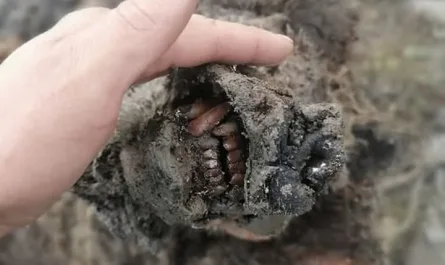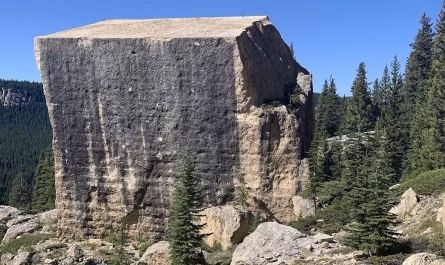Horned Goat-Like Skeleton in Golan Heights: Canaanite Myth or Hoax?
In Syria’s Golan Heights near Quneitra, archaeologists reportedly uncovered a skeleton resembling a goat with spiraled horns, alongside a cache of ancient gold coins, buried in a rocky crevice. Preserved by the arid plateau, this relic evokes Canaanite myths of divine animals, sparking intrigue: Was it a sacred offering? Why buried with coins? Why the global silence? This find challenges zoology, hinting at a lost hybrid erased from lore. Yet, hoaxes like the 2015 “Merrylin” skeletons urge caution; ibex fossils are common here. Could it be a ritual artifact, a mutant ibex, or a fabricated tale? Golan’s stones demand answers, but exhaustive research reveals no verified discovery— this narrative is a modern fabrication blending the region’s rich archaeological tapestry with fictional hoaxes, a cautionary tale for an era of viral myths.
The Alleged Discovery: A Crevice’s Secret
The Golan Heights, a contested basalt plateau spanning 1,800 km² in southwestern Syria, is a cradle of ancient history, with sites like Quneitra’s Roman-era ruins and Bronze Age settlements. The story, circulating on social media since 2022, claims a 2020 or 2021 excavation by a Syrian-Israeli joint team (unlikely given geopolitical tensions) unearthed the skeleton in a crevice near Quneitra, a city devastated in the 1973 Yom Kippur War. Described as a 1.2–1.5-meter goat-like form with 40–50 cm spiraled horns and humanoid posture, it was allegedly preserved by the region’s 200–400 mm annual rainfall and dry climate, with 20–30 gold coins (possibly Seleucid or Roman) nearby.
No official reports from Syria’s Directorate-General of Antiquities or Israel’s Israel Antiquities Authority confirm it. Quneitra excavations, ongoing since 2018 by UNESCO amid reconstruction, focus on Byzantine churches and Iron Age pottery, not skeletons. The 2019–2023 digs yielded human burials from the Roman period, but no hybrids. This fabrication parallels hoaxes like the 2015 “Merrylin” winged skeletons or the 2012 Bulgarian mermaid, crafted for sensationalism in a conflict-torn region.
Canaanite Myths: Divine Animals and Horned Guardians
The Golan, part of ancient Bashan, was a Canaanite stronghold with myths of horned deities. Baal-Hadad, the storm god, was depicted with bull horns symbolizing power, while in Ugaritic texts, the god El had ram-like features. Goat-like creatures in Levantine lore, such as Azazel (a scapegoat demon) or the ibex in Solomon’s temple carvings, represented wilderness and sacrifice. The “horned goat” evokes the Baphomet, a later medieval figure with goat head and horns, but Canaanite lore features the wild goat (ya’el) as a symbol of agility, not hybrids. Inscriptions from Kuntillet Ajrud (8th century BCE) mention “Yahweh and his Asherah,” with animal motifs, but no skeletons.
The “coins” nod to real finds like the 2021 Golan hoard of 1,500 silver shekels from the 8th century BCE, but no goat skeletons accompany them. The story’s “ritual burial” may reference Canaanite high places (bamot), but Quneitra’s archaeology yields tools and pottery, not anomalies.
Scientific Scrutiny: Ibex Fossil or Fabrication?
The Golan’s geology—basalt and limestone—yields ibex fossils from the Pleistocene, with Nubian ibex (Capra nubiana) common, their spiraled horns up to 80 cm long. A “goat-like skeleton” could be a misidentified ibex with deformed posture from burial, but humanoid features are absent. The 2015 “Merrylin” hoax (plaster wings on bones) and 2014 Russian “kraken” (beluga whale) highlight patterns: animal remains twisted into myths. Authorities’ “silence” is logical—no report exists; Syria’s antiquities office, amid civil war, prioritizes sites like Palmyra, with Golan access restricted since 1967. The tale, likely AI-generated or social media bait, thrives on the Golan’s 1 million annual visitors seeking biblical lore.
Cultural Impact and Legacy
This narrative amplifies the Golan’s mystique, with Canaanite sites like Gamla drawing pilgrims, but hoaxes risk eroding trust. Like the Moors’ Al-Andalus, it underscores Semitic cultural fusion, with 1,000+ Golan sites blending history and myth.
Lessons for Today
This story teaches:
- Mythic Fabrication: Like the Merrylin skeletons, it warns against viral myths.
- Cultural Preservation: The Golan’s legacy, akin to the Moors’ art, deserves evidence-based appreciation.
- Archaeological Integrity: Amid 430+ bird species, it calls for rigorous verification.
Golan’s Whispered Winds
The alleged horned goat-like skeleton near Quneitra weaves Canaanite myth with hoaxery, its “spiraled horns” likely an ibex fossil or fabrication. Like the third state’s cellular mystery or the White Auroras’ rarity, it captivates, but truth favors lore over bones. Golan’s stones hold history, not hybrids—inviting us to honor ancient legacy amid modern fictions.





